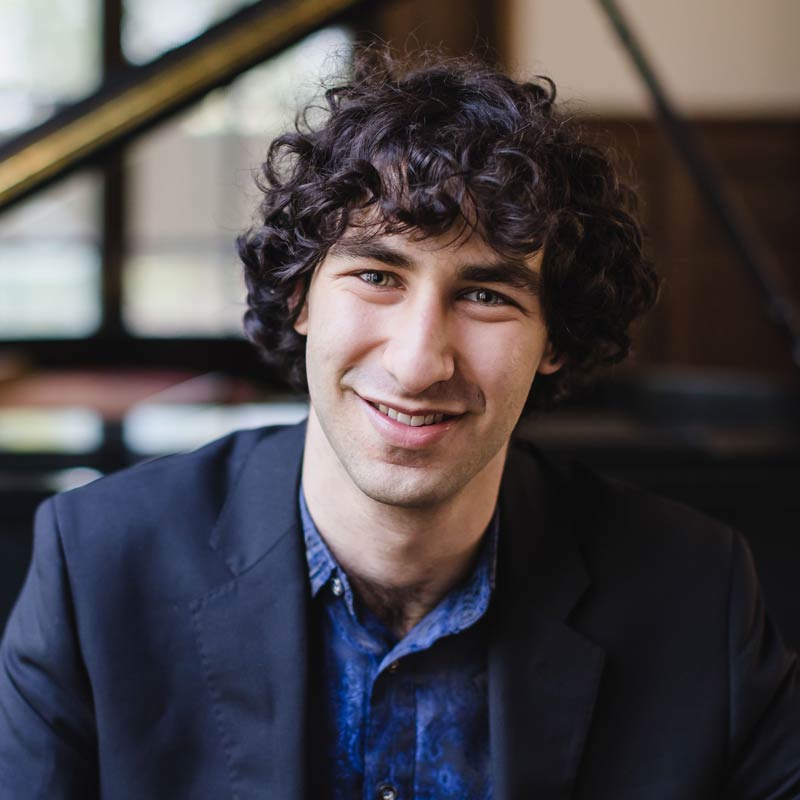Maxim Lando | Saturday, November 11, 2023 · 7:30 pm | Salon Piano Series | Concert in Madison, WI

Photo Credit: Chris McGuire
Maxim Lando
Saturday, November 11, 2023 · 7:30 pm
Program included: Lowell Liebermann, Scriabin, Liszt
Back by popular demand, this exciting young pianist must be heard to be believed. First prize winner at the New York Liszt International Piano Competition, he'll wow you with his program selections and his technique. Lando will perform the Wisconsin premiere of Lowell Liebermann's Three Dances from Frankenstein Op.140, a piece commissioned by Lando with support from The Gilmore Young Artist award.
Maxim Lando will play an 1886 Steinway & Sons Model D concert grand piano. Learn more about this exceptional piano.

Program
Lowell Liebermann - Three Dances from Frankenstein, Op.140 (Wisconsin Premiere)
Michael Jackson - Thriller arranged by Maxim Lando
Alexander Scriabin - Etude in C-sharp Minor, Op. 42, No. 5
Franz Liszt - Der Doppelgänger, S. 560, No. 12 (After Schubert's “Schwanengesang”)
Margaret Bonds - Troubled Water
Henry Cowell - The Banshee
Sergei Prokofiev - Suggestion Diabolique, No. 4
Nikolai Kapustin - Eight Concert Etudes, Op. 40
Sergei Rachmaninoff - Sonata No. 2 in B-flat Minor, Op. 36
Artist's residency activity is made possible through the Annaliese Soros Educational Residency Fund of Young Concert Artists.
Masterclass
Concert Review By Paul Baker
A youthful Maxim Lando stepped before the Farley’s audience November 11 wearing a shiny green shirt to announce his Hallowe’en themed program. The concert showcased mainly 20th Century compositions, ranging from pop music to gospel to jazz fusion to Russian Romanticism.
Over the course of the Hallowe’eny program, the 21-year-old did not actually frighten the full-house audience (he’s far too polite) but came close to blowing the walls and roof off the building with his volcanic energy. His jabbing, stabbing full-body physicality impressed listeners throughout the evening.
Taking all this punishment was the Farley House’s recently refurbished 9-foot Steinway Model D, manufactured in 1886. Farley’s technicians invested 8 months in its restoration, crafting a new soundboard and bridge and replacing every moving component.
Performing Lowell Liebermann’s Three Dances from Frankenstein (2022) required the stamina of an Olympian athlete. A commission by Maxim Lando, Liebermann composed it for a co-production between The Royal Ballet and San Francisco Ballet. Its Lisztian grandiosity would have made full work for four hands, let alone two.
Lando played a suite of three Hallowe’en-ready pieces: his own arrangement of Michael Jackson’s 1982 hit Thriller (its pop theme disguised under layers of Romanticism), and segued into the rumbly Etude in C-sharp Minor Op 42 No 5 of Russian composer Alexander Scriabin (1887) and then into Franz Liszt’s 1839 guillotine-ready Der Doppelganger.
Margaret Bonds’s Troubled Water (1967) develops the melody of the spiritual “Wade in the Water” and serves as the third movement of her Spirituals Suite. (Bonds became the first African-American woman to perform with a renowned American orchestra, the Chicago Symphony.) Set in major-to-minor harmonies, the piece incorporates Lisztian right-hand sweeps alternating with pounding rhythmic chords.
Prokofiev’s 1904 Suggestions Diabolique No. 4 is the final movement of his 1908 Four Pieces for Piano, Op. 4. In Lando’s hands, it suggested the soundtrack of an early Disney cartoon of dancing skeletons. Watching the projected video from Farley’s overhead camera, one could watch Lando execute cross-hand attacks and keyboard swipes worthy of Jerry Lee Lewis.
Given the sheer physical exertion required in the first set, it’s not surprising that Lando returned for the second in a clean shirt (shiny blue). Smiling, he thanked the audience “for sticking with me this far” and suggested considering the remainder of the concert as an adventure in jazz- classical fusion.
Composer and jazz pianist Nikolai Kapustin’s Eight Concert Etudes Op 40 (1984) hinted at Gershwin’s American in Paris, Spanish flamenco music, and the pastel harmonies of pianist Bill Evans. Reference to a 12-bar blues structure and stride-style boogie woogie recalled early jazz pianist Earl “Fatha” Hines and the virtuosity of Oscar Peterson.
Rachmaninoff’s 1913 Sonata No 2 in B-flat Minor concluded the program. The piece evolves over three movements, from pastel harmonies and filaments of melody, to bells of doom and lightning strikes; from grand sweeping themes to dervish dances and stormy seascapes.
